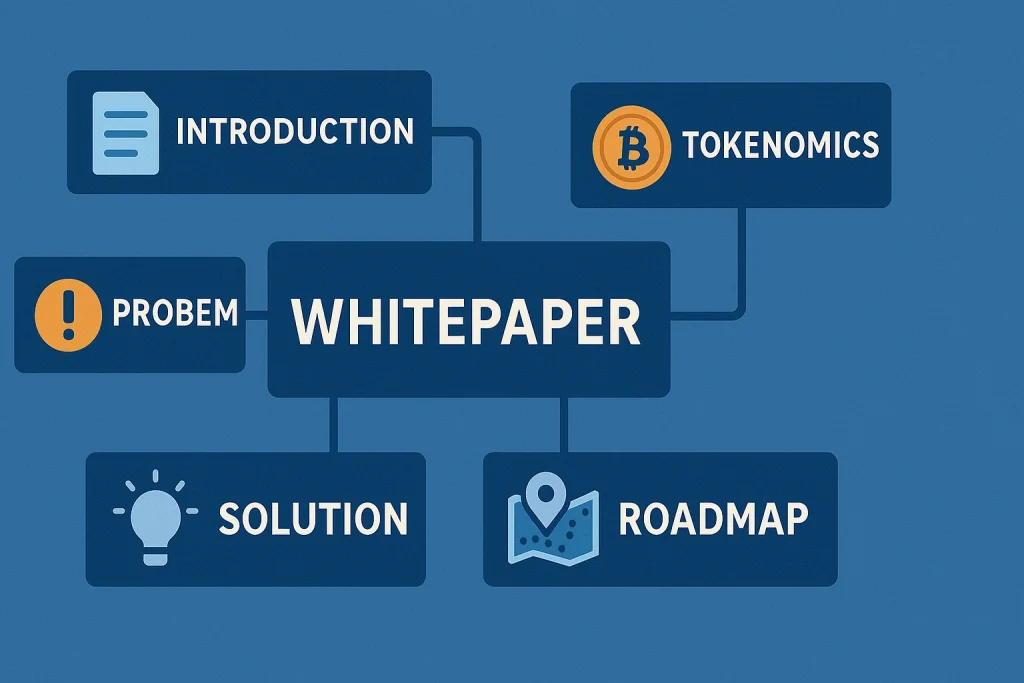What Is a Whitepaper is one of the most important questions for anyone stepping into the cryptocurrency world. It acts as a blueprint, offering details about a project’s goals, technology, and long-term vision. In the fast-growing crypto market, it serve as a first point of trust between developers and investors. When I first read one, I remember feeling overwhelmed, yet fascinated by the technical depth. That moment made me realize that understanding this particular document isn’t optional—it’s essential.
For blockchain projects, it is a more than a document. It’s a storytelling tool that shapes credibility and attracts early support. Investors use it to judge whether a coin market project is worth their attention. Developers use it to communicate how their innovation can disrupt industries. By learning it is, you empower yourself to make smarter investment decisions and engage more confidently in this dynamic space.
What Is a Whitepaper?

It is a detailed document that explains the purpose, mechanics, and roadmap of a project. In cryptocurrency, it acts like a business plan but with a technical twist. It outlines how a token works, why it exists, and what problem it solves. Synonyms often include project brief, technical report, or crypto manifesto. While formats may vary, the central idea is always the same: clarity, transparency, and credibility.
Breaking Down Whitepaper
A typical document begins with an introduction and a problem statement, identifying market gaps like scalability or efficiency. It then presents the solution, the core of the project, where developers showcase their technology or concept.
For example, Satoshi Nakamoto’s Bitcoin paper described a peer-to-peer currency that removed intermediaries—an idea that reshaped global finance. Even today, most blockchain projects rely on such reports to share their vision.
Another key element is tokenomics, which explains token distribution, usage, and value. Details like supply limits, staking, or rewards reveal how sustainable a project may be.
Finally, the roadmap outlines milestones and timelines, giving investors confidence in the team’s direction. Many papers also include technical explanations for developers who want to examine the mechanics in depth.
History of Whitepaper
The concept of a the document dates back to government and corporate reports in the early 20th century. In cryptocurrency, the most famous is the Bitcoin’s document was published in 2008. This single document introduced blockchain as a transformative technology. Since then, it have become a standard in launching crypto projects.
| Year | Event | Significance |
|---|---|---|
| 1920s | Government reports | Early form of whitepapers |
| 2008 | Bitcoin whitepaper | Introduced blockchain and crypto |
| 2010s | ICO boom | Used for fundraising |
| 2020s | Matured projects | Evolve with regulation |
Types of Whitepaper
Not all project documents are the same. Depending on the goal, the intended readers, and the kind of message being delivered, these reports can take different forms. The three most common types are technical, business, and hybrid papers.
Technical Papers
Technical documents focus on the mechanics of the technology. They explain protocols, cryptographic methods, and algorithms in detail, often including diagrams and mathematical formulas. These publications are tailored for developers, engineers, and technically skilled readers who want to assess the feasibility of a project. A well-known example is the original Bitcoin paper by Satoshi Nakamoto, which laid out the proof-of-work consensus and peer-to-peer transaction process.
Business Reports
Business-focused resources highlight the commercial potential and market opportunities of a project. Instead of heavy technical jargon, they emphasize business models, revenue streams, adoption strategies, and value propositions. These reports are crafted for investors, venture capitalists, and decision-makers who want to evaluate return on investment and long-term sustainability. For instance, a blockchain startup might release a business paper to showcase token utility within its ecosystem and how it plans to scale.
Hybrid Documents
Hybrid reports merge technical explanations with business strategies to cater to both developers and investors. They strike a balance by describing how the system works while also presenting the financial incentives and adoption roadmap. These resources are especially common in the DeFi and Web3 space, where projects need to appeal to a wide audience—from programmers seeking validation of the code to stakeholders looking at profitability.
| Type | Purpose | Audience |
|---|---|---|
| Technical | Explain mechanics | Developers |
| Business | Show value | Investors |
| Hybrid | Mix of both | General audience |
How Does a It Work?
The particular document works by communicating trust. It provides readers with evidence, explanations, and visions. Developers publish it publicly, often before launching a token or blockchain platform. Investors, in turn, analyze the document to decide if they should get involved.
Pros & Cons
Every tool has its strengths and weaknesses.
Pros
Builds trust
A well-crafted document helps establish credibility by showing transparency and professionalism. Investors and users are more likely to trust projects that openly share their goals and mechanics.
Explains project clearly
These papers provide structure and clarity, laying out the technology, vision, and roadmap in one place. This makes it easier for both technical and non-technical audiences to understand what the project aims to achieve.
Attracts investors
A strong report can showcase potential profitability and long-term value. By presenting a compelling case, projects can draw in investors who are looking for promising opportunities.
Cons
Can be manipulated
Not all documents are written with honesty. Some exaggerate claims or hide risks, which can mislead investors and damage credibility if discovered later.
Often too technical
Many reports are filled with jargon, formulas, and complex details that the average reader struggles to grasp. This can alienate beginners or casual investors who need straightforward explanations.
Quality varies widely
Since there is no strict standard, the quality of these publications can differ greatly. Some are detailed and professional, while others may be vague, incomplete, or even plagiarized.
| Pros | Cons |
|---|---|
| Builds trust | Can be manipulated |
| Explains project clearly | Often too technical |
| Attracts investors | Quality varies widely |
Uses of Whitepaper

Whitepapers have multiple uses in cryptocurrency. First, they serve as a marketing tool, persuading investors to support a project. Second, they act as a technical guide, offering developers the details needed to engage or contribute. Third, they build a sense of legitimacy. Without a whitepaper, most investors would hesitate to commit.
Fundraising
Projects often release documents during ICOs or token sales to attract funding.
Community Building
It help gather communities around a shared vision.
Regulatory Compliance
Increasingly, whitepapers are used to show regulators transparency and intention.
Conclusion
Whitepapers are the backbone of credibility in crypto, guiding both developers and investors. By learning how to read and evaluate them, you equip yourself to spot real opportunities, avoid red flags, and make smarter decisions in a rapidly evolving blockchain world.
FAQ
Why are whitepapers important in cryptocurrency?
They provide transparency, explain technology, and build trust for investors and communities.
How do I evaluate a whitepaper?
Look for clear problem statements, realistic roadmaps, solid tokenomics, and transparent teams.
Are all whitepapers trustworthy?
No. Some can be misleading. Always verify claims and cross-check with independent sources before making decisions.
Resources
- CoinDesk – Understanding Cryptocurrency Whitepapers
- Investopedia – What Is a Whitepaper in Crypto?
- CoinTelegraph – Crypto Whitepapers Explained
- Bitcoin.org – Bitcoin Whitepaper
- CryptoNews – How to Read a Whitepaper
